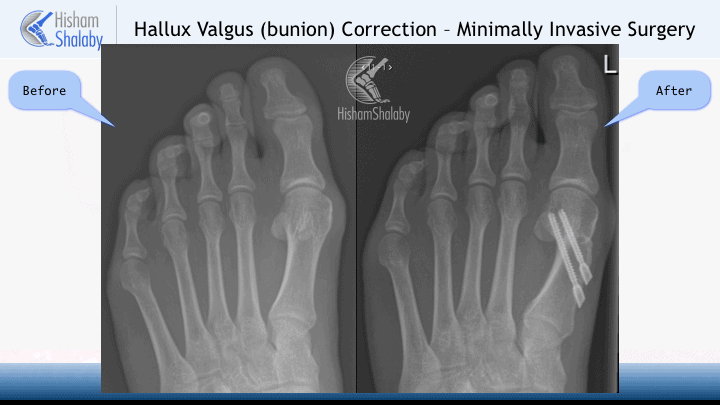Minimally Invasive Bunion Surgery
How is the Bunion corrected minimally invasive?
Why do you need this operation?
Before being offered this operation, you should have tried other measures such as using wide-box shoe-wear, padding the swelling and maybe trying forefoot insoles.
This operation is offered to you if you continue to have symptoms despite trying the above measures and after you have been examined and counselled.
What does the operation involve?
The operation is done as a day case, but come prepared in case you need to stay overnight.
The operation is performed with general anaesthetic and nerve block (which means numbing the nerves of the foot).
The operation involves two small incisions on the medial side of the big toe. One is used to shave the bunion with a special burr and to perform a cut in the bone with another burr. Through the same incision, the bone is displaced to correct the deformity.
Through the second incision screws are introduced to fix the translated bone. Further stab incisions may be needed to do a percutaneous Akin osteotomy.
The operation is done under x-ray guidance.
You will use crutches if needed as well as a surgical shoe “the off-loading shoe”.

Your post-operative period
- You must keep your foot raised for the first two weeks and if needed afterwards.
- You can put your full weight on your foot using the surgical shoe for the first 6 weeks.
- There is no plaster needed following this operation.
- Use crutches if needed.
- Exercise big toe movements at two weeks
- The swelling may last for a few months going on and off and finally fading away.
Your follow-up
- At two weeks, the dressing is reduced and the stitches are removed
- At 6 weeks, you have a follow-up with x-rays
- Off work for 2 to six weeks depending on your job
- No driving for six weeks.
What are the possible complications?
- Infection
- Sensitive or painful scar
- Big toe permanent numbness
- Joint stiffness
- Under-correction or Over-correction
- Failure of bone healing (non-union)
- Recurrence of the deformity
- Avascular Necrosis of metatarsal head
- Clots in the leg (DVT)
- Clots in the lung (PE)
- Chronic Regional Pain Syndrome
Smoking, diabetes, rheumatoid arthritis or being on steroids or blood thinning medication increases possible risks significantly.
Is this technique better than the open technique?
The gold standard surgical correction of the bunion deformity is the Scarf & Akin osteotomies. The minimally invasive technique is suitable for a group of patients where it can have the benefit of less scarring. The recovery period is the same following both techniques and there is no evidence in the current literature to suggest that this technique is better or worse than the open correction.
For information on the open surgical correction click here.
